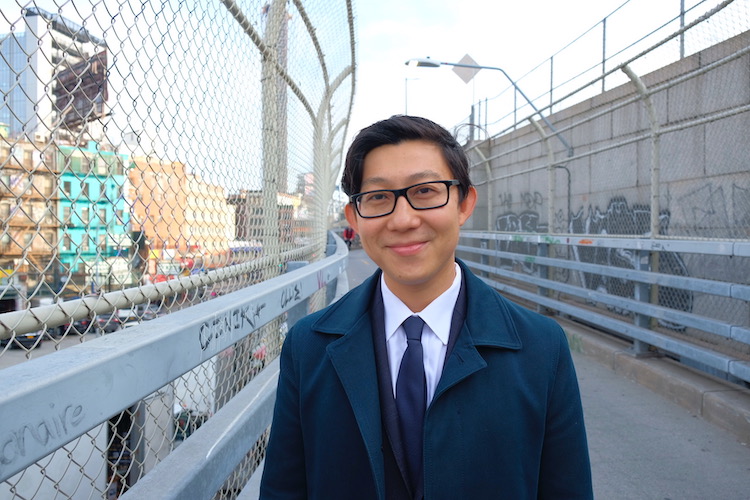Playwright and Director Kyoung H. Park isn’t afraid to get political. The founder of Kyoung’s Pacific Beat, a peacemaking theater company based in Brooklyn, New York, Park knows that theater and the arts at large have the potential to change our minds. Park and Kyoung’s Pacific Beat are creators of cultural change, inviting us to interrogate why peace matters, how peace can manifest as a reality in our world, and how artists can lead us toward a transformation of our culture of war into a culture of peace. I had the opportunity to talk with Park about creating political theater, the artist’s responsibility, writing intersectionally and holding space for marginalized voices.
Your plays tend to take on political issues. How do you balance writing the political and the personal without veering into something that comes off as propaganda and the didactic?
Sometimes I fail, and my writing comes across as propaganda and didactic. Because of the subject matter of my work, it is necessary for me to stage conversations about politics, to unpack what certain things mean; there’s a kind of pedagogy to the work that we do, to steer audiences to places where they are challenged to think critically about their assumptions.
My work can come across as didactic because I’m also an overeducated writer. Between the fact that I have spent a lot of time studying in academia and was a professor in South Korea before starting my theater company in Brooklyn, the teacher in me appears in my writing and he likes to lecture. I try not to do that but the press, presenters, and even funders have criticized me for over-intellectualizing things on stage and alienating audiences. Sometimes I take that feedback to heart and make edits, but sometimes I decide not to compromise, and that’s a choice I allow myself to make.
I’m OK with staging political theater because I balance very dense, and overwrought political language with a lot of dialogue that is based on nonsense and absurdity. I’m asking impossible questions, like can the theater help us create a culture of peace? I know that my questions are going to take us to places that have no answers, and that’s the cliff that I want to jump off from. This is when I’m the most artistically challenged to find new ways and forms of expression, to search for answers and for truths that may not exist, or that may require new language for it to be articulated.
In a way, I’m writing to reach the limits of my own understanding, in order to force myself into a state of imagination, invention and creation—of world peace. I find this both optimistically naïve and seriously ridiculous; tonally, my work comes across as both.
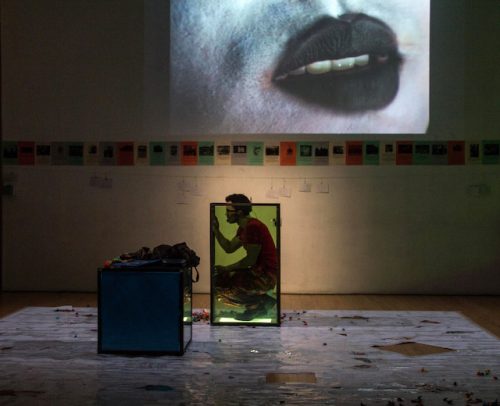
Often writers from marginalized communities are expected to represent their communities wholly. How do you work with and past that pressure?
I self-identify as a Korean, Chilean, queer, immigrant artist, so I find it very hard to represent my community wholly because in reality I belong to many different communities. And even though New York City is a very diverse city where I’ve been able to find a Chilean community, a Korean community, an immigrant community, and even a gay, Asian-American community, I have to say that a lot of these communities are socially segregated.
Luckily, through the theater, I’m capable of writing very complex stories that represent different facets of my experience, and because theater is the most social of arts, these socially segregated communities can come together whenever I produce my work. In a way, this gathering of diverse strangers has become an opportunity for us as a company to build a new, different kind of community that transcends identity politics and current, social dynamics, to bring together a more plural—perhaps, intercultural—kind of community where many of us can relate to the stories and experiences being shared on stage.
You founded Kyoung’s Pacific Beat to open the stage to marginalized perspectives in society. How do you see as your role in terms of creating space for those folks?
My role has been to facilitate space for artists not only of different racial or cultural backgrounds, but finding collaborative models for artists working in different disciplines. I’ve developed work in collaboration with choreographers, visual artists, composers, video designers, people who have perhaps never worked in the theater before, including local community members who have never had experiences working in the arts, at all.
So for me, creating diversity and complexity in the collaborative process goes beyond race, to be inclusive of non-artists, and given my experience working with immigrant and queer communities of color, it’s also really important for me to ensure that our work environment and performances are safe for people who are closeted or undocumented, and that our presenting venues will not racially profile our artists and community members.
What are the biggest challenges to getting marginalized voices onto the page and stage?
The biggest challenge with making my work today is dealing with whiteness and this problem is two-fold. First, I don’t make the work for white audiences. Meaning, in our process, I center artists of color, stories from people of color, and stage our work for communities of color. Because of that, white institutions, literary managers, presenters, and funders often struggle to connect the work that we’re doing to their white constituencies and to be honest, that’s not my priority. My priority is to ensure that our work authentically represents experiences of people of color and that our work remains safely accessible.
As we keep growing in profile, we’ve come across a second challenge, which is how to best work with predominantly white institutions that have an exclusionary history. Some of our company’s Leadership Council and more radical constituency will not agree to enter and participate in predominantly white institutions due to their history under-serving and under-representing communities of color, so as a company, we’ve had to turn down working with certain institutions to ensure that our community feels heard and safe, wherever we showcase our work.
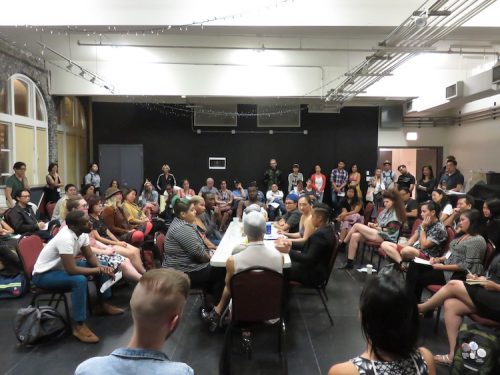
How did you develop what you call the four foci of Kyoung’s Pacific Beat, “Creating Peace, Queering the Social Order, Securing Cultural Democracy and Representation, and Devising the Future”?
Kyoung’s Pacific Beat’s organizational model was, from its inception, created to promote a culture of peace and non-violence. This was a very conscious decision that I’ve made as an artist, for which I spent seven years in higher education figuring out how to achieve this, while traveling around the world to work with theater companies like the Royal Court Theater in London, Augusto Boal’s Theater of the Oppressed in Brazil, and Young Jean Lee’s Theater Company and Mabou Mines in New York. Through our company’s work, I am putting all of this theoretical research into practice.
The foci of our work has been the result of the productions, community-based conversations, opportunities and challenges we’ve faced doing our work for the past eight years. These four foci have emerged from our practice; they weren’t determined before hand, but rather developed in conversation with the communities we serve. In the next two years, I see us deepening our commitment to these four foci, while expanding our work into one more core area, which centers the intersections of feminism, ecology, and faith.
Do you think it is an artist’s responsibility to work with a focus on leading progress? For artists to lead society toward a more just culture, toward a culture that disrupts cycles of oppression and violence? How can artists working right now support this action?
I do think that it is important for the arts to disrupt cycles of violence and oppression, whether it’s the intergenerational trauma that exists within families, or challenging the cultural norms that normalize the violence we are witnessing in society. I feel that the arts have a civic responsibility to do something about social injustice and I am personally motivated to do this because as North Koreans, my family has experienced the impacts of war, military dictatorship, diasporic emigration/immigration, colonialism, Imperialism, and the severing of our selves from our land—for three generations! These experiences of oppression are not just inherent to my experience, but are part of anyone who has experienced persecution and discrimination, especially based on their identity.
I feel that the cultural sector, and the arts in particular, have a great potential to change our minds. Kyoung’s Pacific Beat operates at that level of cultural change. My work is an invitation to ask ourselves why peace matters, how we’d like to see it manifest into a reality in America, and how artists can help us achieve this by steering us towards the creation of a new cultural paradigm that transforms our culture of war into a culture of peace.
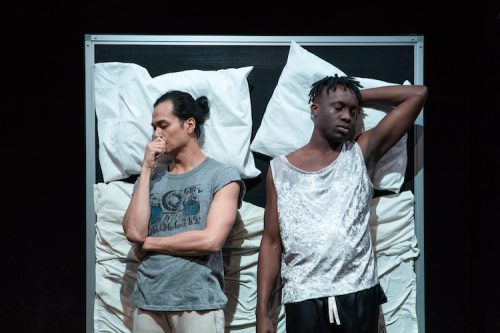
Writing intersectionally is not necessarily the norm in theater, especially political plays. When you started writing PILLOWTALK, did you have it in your mind to create something that took on an intersectional conversation?
I decided to make one of the characters in PILLOWTALK African-American, to center conversations on racism and interracial relationships as a core part of our project. As our developmental process became public, the Black Lives Matter movement became prominent in the mainstream and affected our company’s conversations about race.
By the time we premiered PILLOWTALK, we knew that we had to uphold a race-centered discourse about our project through public conversations, sharing our stage with black, queer women, trans, and non binary individuals working in the arts, academia, and social justice.
How did you ensure that the conversation didn’t become one-sided or myopic?
Kyoung’s Pacific Beat was fortunate to receive our first public grant to develop community partnerships with multiple, POC organizations in the city, and to collaborate with PeopleMovr and a team of queer, POC community engagement experts, to make sure that our community led the critical debate on our project and defined what it collectively meant.
We knew that if PILLOWTALK was defined by the white frame / white male gaze that continuously frames queer, POC experiences, especially in the media, we would have been another victim of mainstream criticism and unconscious bias. In order to combat that, we set-up strategies for a collective, queer, POC, critical debate through community-based, grass roots, advocacy strategies. By finding the appropriate leverage points in our community, I think our cultural, guerilla tactics worked.
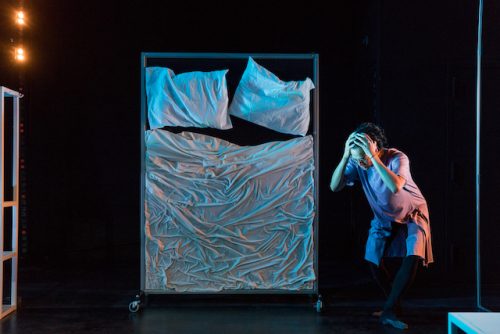
You started writing PILLOWTALK before the 2016 election. How did the results impact the play and your approach to the subjects it addresses?
By the time we started our final leg of developmental workshops in 2017, our theater company had deep questions about the relevance of our work given the election results. We were in a different political reality, but the backlash against the Black Lives Matter and marriage equality movements became more palpable with time.
In this new context, PILLOWTALK seemed to be less critical of progressive politics, and became more of an act of resistance against current, conservative politics. I don’t think our story or our intentions as artists changed. I think the mainstream culture shifted direction following the elections, but we didn’t adjust to that conservative backlash. We kept pushing forward, acknowledging that the pushback against our work was simply going to be harder.
Sometimes, we wondered if we were missing an opportunity—or responsibility—to speak more concretely to the realities of this new Presidency and Administration, but the truth is that PILLOWTALK expressed skepticism about the progress celebrated post marriage-equality from its first incarnations. In our skepticism, we encouraged ourselves, and our audiences, to truly question whether marriage equality supports the needs of queer communities of color and based on ongoing responses, and continuous interest in PILLOWTALK, I know that our work is far from being done. PILLOWTALK will keep on going.
Writing a play is very different from rehearsing a play. How does your process change once you’re rehearsing your own work?
My process takes multiple years, so I enjoy writing and rewriting a play for different reasons. When I’m first writing a play, it’s from a place of subconsciousness. The writing is structure-less, character-less, form-less; I’m basically writing and exploring the needs of voices in my head. Usually, these needs are closely related to something personal that I’m going through, so I continue to write until I get to a point where I can articulate what the play is asking from me.
Once I can articulate what a play may be about, I start conversations with my collaborators—actors, artists, and designers—and together, we go through a process of improvisation and experimentation in the room, to unveil what are the larger ideas being explored in a play. Through Kyoung’s Pacific Beat, I’ve collaborated with several artists for a number of years, so we’ve developed a shorthand to make artistic decisions quickly and intuitively. Most importantly, we’ve created the trust needed to challenge ourselves—and the work—knowing that we are all listening to each other, and that my goal is to maintain a space for all of us to find our voices within this work.
How do your conversations with the actors and designers help inform your rewrites throughout the process?
Towards the end of the process, the crafting of my writing has a different purpose. By then, I shape the text for performance and strip away everything that is not necessary in the script, because I take into consideration everything else that’s being said on-stage through acting, music, movement, and design. The language is minimized and shaped into freeform, verse-like lyrics, and I’m thinking about how each word functions as dialogue, as sound, and visually on the page. When I’m fine-tuning work like this, I know I’m reaching the end of my writing process. And by the time a new play receives its World Premiere, I make a mental decision to freeze the script permanently. I freeze them so that I let go of the work and let it live as a live performance on-stage and allow the production to be my final draft.
For practical purposes, I also use premieres as an opportunity to move on to the next play. That’s necessary for me because I’ve got four plays waiting to be completed on my desk. Whether I want to or not, I have to make the decision to move on.

What’s next?
Next for Kyoung’s Pacific Beat is the World Premiere of NERO. NERO is the story of George W. Bush’s Presidency and the War on Terror, told through the anachronistic theatricalization of the rise and fall of Nero’s Roman Empire. Nero is performed by a straight, white male actor, surrounded by a diverse ensemble of nine actors of color, and the show explores white supremacy as the roots of American individualism, American exceptionalism, and US Imperialism. My hope is that we can premiere NERO during the fall of 2020, before the Presidential Elections, and as a company, we’re asking ourselves whether we, as artists of color, can create a cultural shift by raising awareness of how white supremacist culture has gotten us to where we are today.


